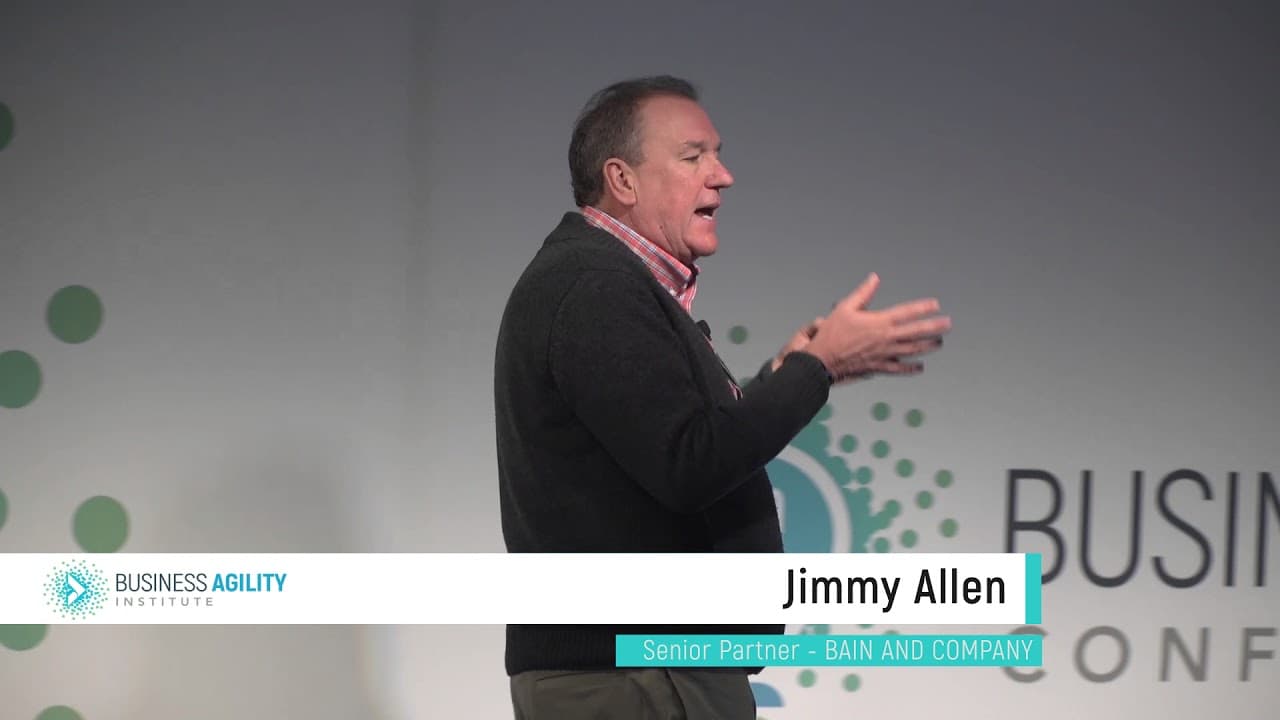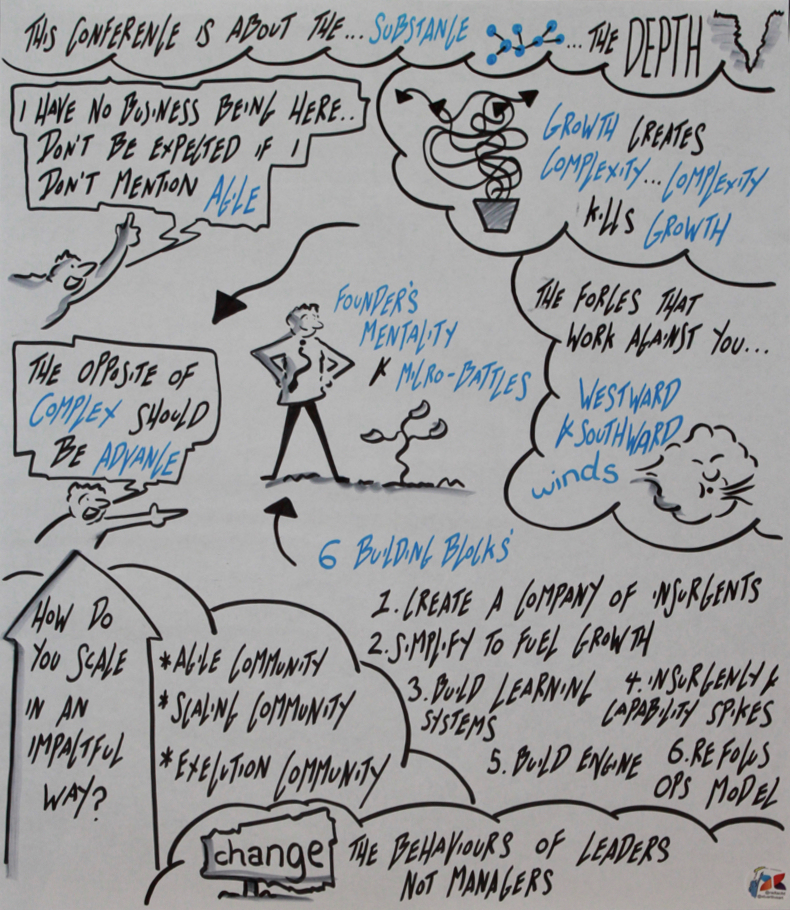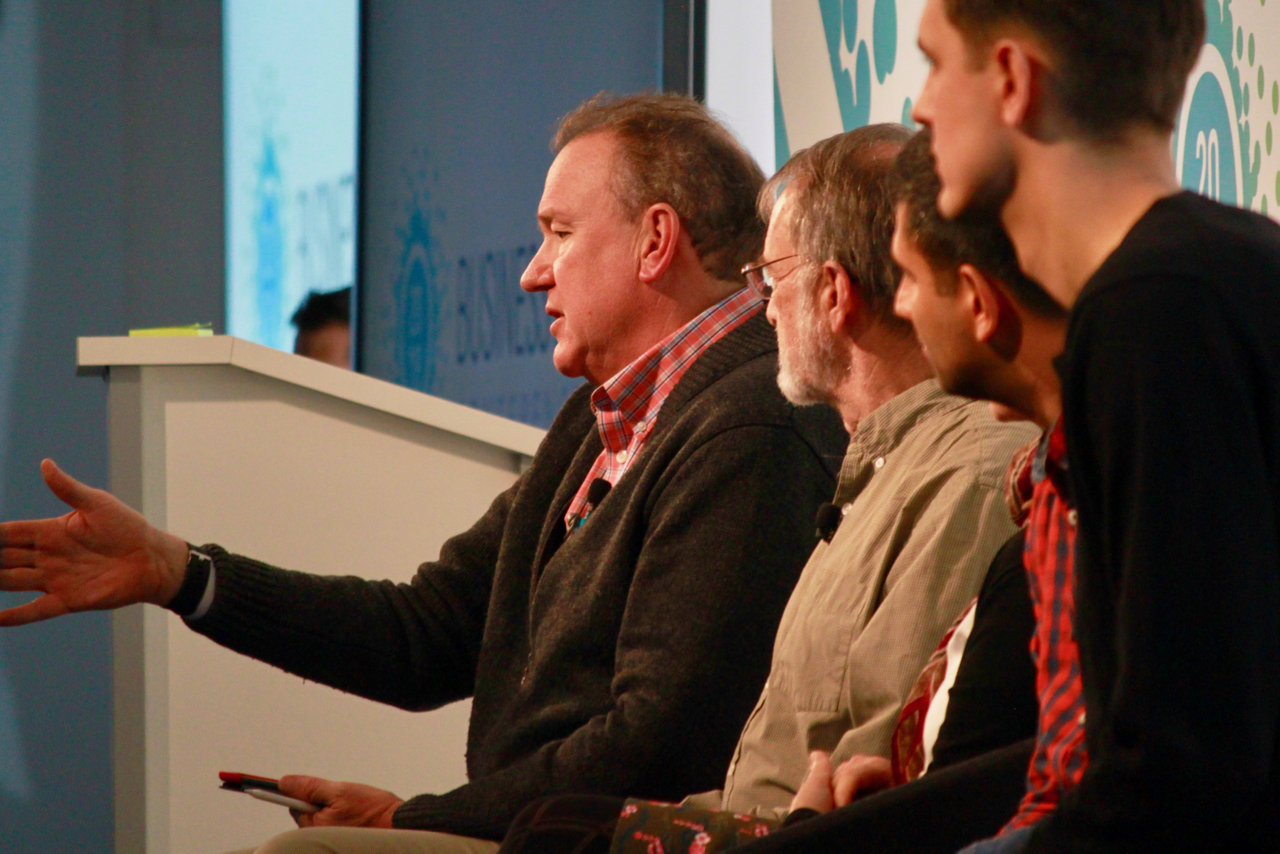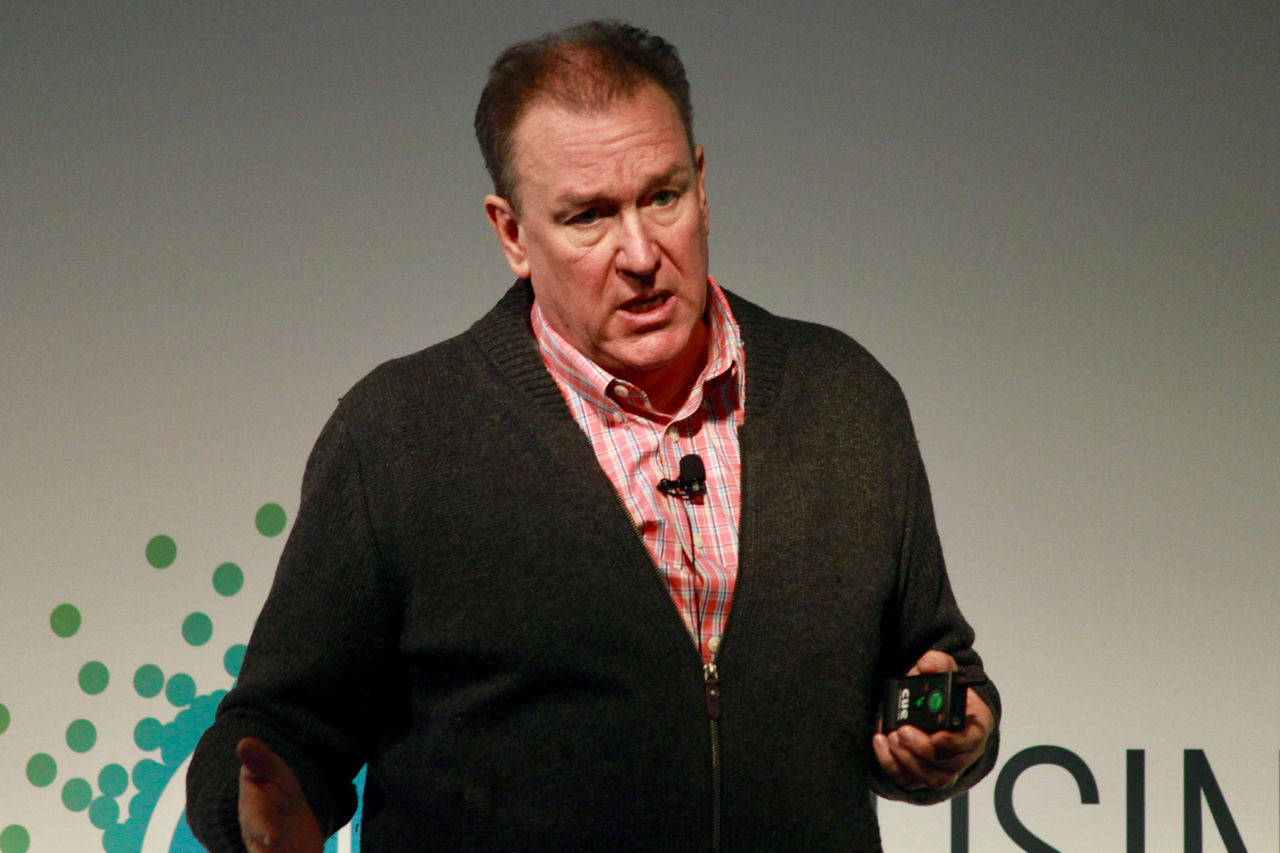So I have one primary goal of this talk, which is well, which is probably to demonstrate that I have no business being here, so I hope I can show that.
I didn't know I was talking about Agile until Ahmed told me I was talking about Agile.
And so he invited me here.
But you won't hear the word and I'm so afraid if it's a noun or a verb, I don't even want to bring it up as I go forward.
But our, my journey. I head up Bain's global strategy practice and so my journey is just very different and it starts with: how do you make companies grow sustainably and profitably?
I'm going to tell that journey very quickly through about eight slides and then I'll pause and take time on slides.
Don't get frustrated, you don't need to take pictures. Everything's online so you can see all this. But I'm just going to do it on the journey.
And the journey starts with my very first project at Bain was in 1988 and I was told to look at the global 2000 companies and read their annual reports and see how they were projecting for growth, and the data that I discovered is the same data today, which is on average, if you look at the global 2000, the CEOs of those companies are projecting to outgrow their individual industries by two times on a revenue basis.
But they have a profit kicker, which it will outgrow on a profit basis four times.
So the entire world of business sits in meetings like this and conspires to take market share from the entire world of business.
And it's a reasonable question to say, "How many companies on a sustained basis outgrow their industry by 2x?"
And the answer is one out of 11. One out of 11 and my first journey was, who the hell are those guys? And it turns out that the one out of 11 dominate their core business.
And so while everybody in growth wants to chase shiny objects, you actually have to return to your core.
And we wrote a book called Profit from the Core, but then we got obsessed with the 10 out of 11.
Why aren't they growing? What's going on?
So we asked them, why do you fail to grow?
And again, you don't have to read the data. But in only 15 percent of cases when management had to explain their failure to grow and only 15 percent of cases did they blame the marketplace. Eighty five percent, they blame themselves: inability to focus resources on the problem, deal with risk aversion. We never added capabilities, shitty business planning, et cetera, et cetera.
And we call this the growth paradox, which is growth creates complexity and then complexity kills your growth.
And so you have to start thinking about what is what is a company along two dimensions, the first of which is how well did they maintain their sense of founder's mentality, which I'll define in a second, and how well do they benefit by size and by definition, every great company starts as an insurgent.
They're at war against their industry on behalf of underserved customers. And the aspiration of that team is they have scaling, is to become somehow the incumbent in their industry and the entire world of v.c. and management and investors are all there to make them professional and bring in adult supervision.
But that journey comes at a huge cost, which is the loss of any sense of founder mentality. And we define that on three dimensions.
The first is this insurgent mission and complete acknowledgment of your spikey capabilities. Founders know they have to be great at one, two or three things and they're allowed to be crap at the rest.
Incumbents start having the tyrannt of functional excellence programs.
Everybody wants to benchmark themselves against other functions and other industries completely independent of the strategy of the company in the insurgency.
Wonderful example going on in the U.K. This is Charlotte Tilbury, fastest growing single personal care brand in history, and she's at war against the entire personal care industry.
Second dimension is front line obsession. There is no discussion of strategy or organizational topics unless it is translated into a front line routine or behavior.
As you know, in incumbents you can have months of strategy and organization discussion and no one gives a damn about front line return or behavior.
Charles Schulz had to come back into Starbucks because what he said was the barista, we had forgotten that the barista was the king of our business, and the professional managerial class suddenly starts believing they're important.
Third is owner mindset, and owner mindset - there's a lot of things here, but I'll just bring up subtle stuff that starts to happen in a company.
In insurgent organizations the people that get ahead make problems smaller. In incumbent organizations, the people that get ahead, make problems bigger.
We have a China pricing issue.
A founder says, "We don't have a China pricing issue. It's three products, four stores, everybody on the phone. Let's solve it."
An incumbent organization: "We don't have a China pricing issue. We have a decision rights problem between our functions, our markets requiring a thorough review of the operating model, which will take 18 months."
And the reason for this is what happens in incumbency is that the opposite of simple becomes advanced. In an insurgent, the opposite of simple is complex.
If the opposite of simple is advanced, anybody who has an idea to add a slide to a budgeting template, a committee to study committees, a step, a new step in the innovation process, by definition it's more advanced and so no one can say no.
If the opposite of simple is complex, someone is screaming: "This is adding costs and complexity to our consumers, is she willing to pay for it?"
This is a LOT to lose. It is a lot to lose, but we don't notice it on the journey because as we professionalize, the professional managerial class is trained to capture the benefits of size. And so for a while, this journey seems positive.
We are losing tremendously the culture that got us to where we are, but we are gaining professionally with the benefits of size.
But then here's the problem: the world of incumbents are now staring at the new world of insurgents and saying to respond with speed and agility to what needs to happen, our size is no longer an asset. It is actually a liability and our argument is this is just the default path.
This is why the evolution metaphor matters in business, because companies grow and then die and then the next insurgents come up.
The evolution metaphor isn't very nice for the individual company. It's great for the consumer, but it ain't nice for the company, and so the issue is how do you avoid this default path?
So we wrote the book.
At the time we interviewed 170 founders. There was such demand to talk about this that we then formed what was called the Founder's Mentality 100 where we started with one hundred -it's now six hundred eighty four- insurgent companies meeting in thirty four forums about how do we avoid this, how do we avoid this path.
And then incumbents have started to join.
So the first issue that we began to define is what are the forces that actually work against you And so we had to learn about sailing: westward winds go westward winds go east, west winds go - I mean, west winds go east.
We had to learn about that, and we identified what happens to the small company.
I won't go through the detail, but everything about the act of scaling and gaining the benefits of scale destroys your founder mentality because you're bringing in a professional managerial class who start to think they're more important than the people that built the company, more important than the customers, and this is what goes on.
And a huge amount of our energy in the first time was this whole pain of the transition from a hero culture where a twenty three year olds did heroic things to a systems culture where you don't promote people because it erodes the integrity of the system.
Then you have the southward winds that finish you off.
I'll just bring one example up again, not going through detail, but one example is Curse of the Matrix.
So The Matrix is here to stay. But what we have forgotten in companies is that the purpose of good organizational design is to create conflict.
And I'm going to say it again: the purpose of good organizational design is to create conflict. Why? Because your consumers benefit massively by you fighting.
If I'm Unilever, I want the head of Indonesia to fight on behalf of her consumers for spicier soup. She is delivering the benefit of intimacy and difference.
But in the exact same debate, I demand the head of supply chain fight on behalf of consumers for the benefits of Unilever's scale and sameness.
So yes, we can deliver spicier soup, but really? Fifty-two different kinds of mustard seed?
Second conflict: Routine Versus Disruption. Eighty five percent of firms' activities are executing against a known playbook with some form of continuous learning in it.
When I get onto a plane, I do not want to be on the first Agile flight. I want to benefit entirely from the entire history of aviation, and the routines that have been established and lessons learned. That's eighty five percent of firm activity: routine.
Then we have Agile and disruption, which is a small part, and we want to fight. When do we have execution and routine, and when do we have disruption and how do we think about it? The second big conflict.
Third is short term versus long term. We build this conflict in, and then we lock it into the silos - so we forget to do one tiny little thing, which is to resolve the conflicts. And this is what is killing the modern enterprise, is this desire to capture both the benefits of size while retaining some culture, creating conflict, creating all sorts of things, the professional managerial class then in charge and thinking they're important.
So, second thing we said is obviously this isn't some retreat to a mythical past. The goal of a company has to become, to become a scale insurgent.
How do I capture the benefits of size while retaining the sense of founder mentality, and how do I go about doing that?
And so that's been our journey as we talk about it, and that journey somehow got us into the Agile space accidentally.
And so we had a series - I'm not going to go through it again - but we started with the "what" you know, if you have a problem with insurgency, here are two ideas.
If you have a problem with front line obsession here are two ideas we created with founders.
If you have a problem with owner mindset, here's two ideas.
And we started with that and co-creating and workshops how you deal with that.
And if I had time, I'd tell you really sexy stories about all these.
But what we discovered is it's all about the "how", and the "how" is that on this journey, you actually completely lack the capability, skills and behaviors to become a scale insurgent. And this is what not enough conversation is about, is the behavioral change.
What everybody is saying is you can form an agile team and they do great. They then collide with the hierarchical organization and they die a very slow, painful death - and so a lot of our conversation is to go to the scale insurgents that exist - the Facebooks, the Googles - and figure out what are the skill sets they use and begin to break it down.
So we then went back to founders and started going through "what is that journey?"
And so now I'm slowing down and it'll be three slides just on that journey. So we said, "What is the act of taking strategy and turning it into execution?" And for the best founders, it's really about launching a micro battle.
And I was on a panel one time with Charles, with Brito, Carlos Brito from ABI and Howard Schultz. And we were talking about this, and Howard Schultz says, "Isn't it amazing when you get to reach a certain size. All of your corporate strategy initiatives take exactly 18 months to fail."
And what he was saying is, we throw out strategy when we're really throwing out chapter headings.
When in China, that's not a strategy - that's a chapter heading for something to be written, but it ain't a strategy.
So when we talk about a micro battle, it's saying, how do you take strategy and translate it into the first failure point where you need to begin prototyping?
And it is a very hard act, but the best founders in the world are brilliant at this.
I work very closely with Bart Becht. Bart Becht is the legendary CEO in Europe of Reckitt Benckiser. Took him from seven dollars to seventy six dollars share price.
He is a master at translating strategy into first failure point.
So I used ABI as an example. They'll have a strategy called "Win in China", and we know to win in China you need to add a lot of Chinese brands to build distribution scale, you need to add a sales force. But to win in China, Budweiser has to beat Carlsberg and Heineken. There is no other way to win in China.
And for those of you who know the beer trade, that's not just winning, that is winning in the on trade in the most aspirational bars with the most aspirational Chinese consumers.
The normal way you would find out is a trade promotion test and then retest, which takes about 18 months. A micro battle says six different bars, four different trade promotions every four weeks.
Twenty four micro battles later, they found something that could beat Carlsberg. Four months in to the strategy. Not 18 months in, finally test something - that's a micro battle.
And a micro battle, on one hand is, I think, Agile. It's the process of taking strategic intent and translating it into something you can prototype. But that's necessary or not sufficient because that falls into the pilot problem, and the pilot problem is anything properly resourced with huge executive attention always works.
But then if you throw it into an organization with all the resource constraints, it never works. And the problem is, is because there's another part of the process, which is how do we scale that innovation across the organization, translating prototype into repeatable model and then figuring out a deployment model?
And this is what people aren't talking about is the right hand side enough. The left is getting back our mojo to define our mentality, but to be a scale insurgent, we have to get the process of scaling. And at least my experience when I talk to Agile teams about it, often the definition of "scaling agile", - I think it's a verb or a noun I don't know - is we're scaling it because we used to have three agile teams, now we have 500.
But that's not scaling it so it has a strategic impact on the organization.
And this is the debate, I think, and as we've gone through what's required here, - and I'll come to lessons at the end - the one thing at least that we've discovered is nobody is talking about the third community.
What do I mean by this?
We started to look at it in detail, and companies are kind of made up of three communities, but no one's really talking about it.
One is the execution community. They take playbooks and they execute. They're incredibly busy and they're the heroes of the company. They are the heroes of the company.
Then, we're starting to introduce Agile disruption - the innovators.
But who takes a prototype and turns it into something that the execution community can do something with? And we started to say that is the scaling community, that is a group of people.
So working with one FS player, working with an FS player it's clear that in order to transform, we're going to need transform customer experiences. To transform customer experiences you need to pick a customer experience and also transform business processes. Transform business processes, you're going to have to have an I.T. fix.
Then there's only a tiny little problem, because the professional managerial class and in that FS company outsourced I.T. 15 years ago. The I.T. skill set is how to manageoutsourced contracts, not how to code.
So you go from "we have a prototype, we need to get this into something" execution, but we haven't built the coding community that can deal with this. And this is what we see people not talking about, is this middle community and what to do.
Really interesting thing. We began to profile. We've launched a whole thing where we're actually profiling the personality characteristics and what they are. And there's one common characteristic. They're the bastards in your company now, complaining like hell that the stuff you're coming up with and prototyping is unrealistic and won't be scaled.
They're the ones that are saying "that's sexy, that's cool, but it's a Post-it note and how am I going to get 12,000 salespeople to do it in a day where they have forty seven activities a day?", and you say "you're not agile, you're a bastard, you're grumpy."
And this is the issue that we're trying to deal with - there's a lot of these people are massively undervalued because they're ahead of you. They're already in the implication of bringing in to playbook, and you're still improving the prototyping an Agile school.
So this is the journey we've been on. Then the second journey is something very interesting, at least for us, is everybody wants to talk about Agile teams, for God's sake, keep them away from management.
Let them be empowered and liberating. All you're doing is postponing the inevitable, which is management will eventually kill them. That's what management's job is. They hate this. They are not telling you they hate it, but they hate it with the passion.
So what we're saying is, if you're going to run micro battles, you have to have those micro battle teams report into the leadership team at least once a month, and you use those moments to change the behavior of the leadership team - not the Agile team.
And you have to deal with it, because you can't just say, "Agile, we're going to completely transform that way alone and never change leadership behaviors."
They are waiting to kill it. They are giving it time. They believe it's a fad that's going to run out and they just have to say it long enough to shareholders 'til they get through it. So that forces say, what are the skills - and someone else used the same thing - of what amplifies the effects of a micro battle, or an Agile team? What is the leadership team meant to do? They have to set strategic direction and make sure they know what the first failure point is. That's an act of leadership.
Bezos would never have a strategy that goes out without beginning to have a talk about first failure point.
They have to double down on winners. The whole process of a corporation is never to double down on anything.
Right. You give five percent. You say we have big strides, you want to grow X, you find out how much discretionary research applied to the new strategy, maybe one and a half percent difference from the year before.
All budgeting simply allocates last year's revenue and everybody wastes their time until they arrive at that conclusion.
Third, we have to accelerate the cadence. Their job is "how do we get faster?" Their job is in the meetings, to say "stop making problems bigger, make them smaller. We need to help and enable this team."
They have to also then deploy the scaling community. Who else is doing it? The Agile teams are working. They need the support of the scaling community and somebody better be building it. And then they take the findings of micro battles, how the organization is learning, and rethink what the company's strategy is.
And so the burden which - and I get yelled at all the time by people in the Agile community - the burden of an Agile team to have to change the behaviors of the leadership team is just a fact.
You want to say differently, you want to leave them alone, but everybody can have fun parties, but eventually you have to come to work and that's changing their behaviors.
And so that's a big deal.
So then final thing, I'll just say we started collecting the full list. And again, this is online, but I'll just bring up a couple things.
One is the difference between a prototype and a repeatable model is a very big leap and it's an iterative process. It actually changes what you prototype.
The second is when we think about execution, we tend to jump to playbooks,and we don't spend enough time worrying about how are we going to change the behavior, the time and the money of the people that are going to have to deploy this, and how do we think about it and not just rush everything to playbooks?
One other thing then just to highlight is as soon as you start this, the first thing that immediately comes up is you need a new deal for talent, because the journey to become a scale insurgent is to become a flatter organization. And the only weapons that the modern enterprise has to professionally develop their people are the promises of spans and layers.
The only way you get ahead is to get further and further away from the customer or have more and more cost and resources under your control, and we have to think, how do you keep a person as an active, thriving member of your enterprise staying close to the customer and in an execution role? And this will be the challenge of our age.
We just started a new exercise called From the Future, where we said the big issue going on with all of us is we're in between eras. There's only been seven eras in the history of business. We're moving from the shareholder era to the era of the scale insurgent. The change of eras changes everything, and we're at day one of that journey.
Thank you all.



 Only about one company in eleven has sustained profitable growth during the past decade—and for those that failed to grow, over 85% of company leaders blame internal factors for this shortfall.
Only about one company in eleven has sustained profitable growth during the past decade—and for those that failed to grow, over 85% of company leaders blame internal factors for this shortfall.



